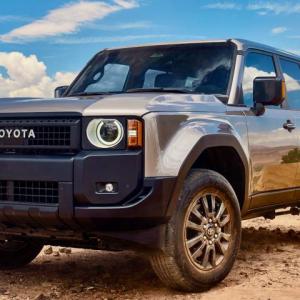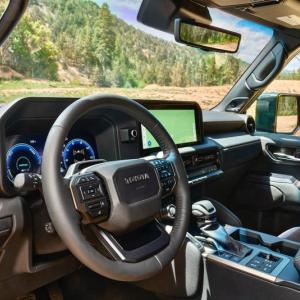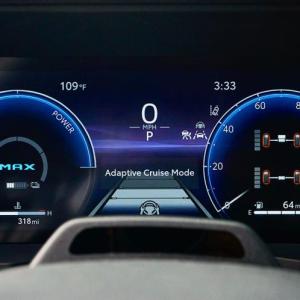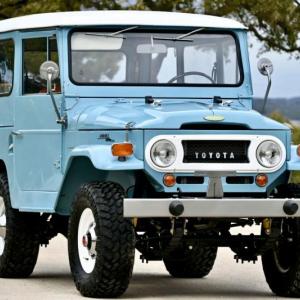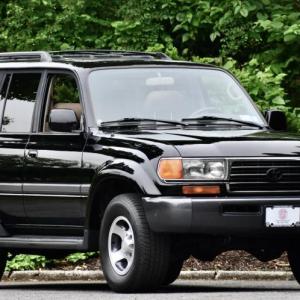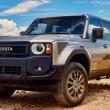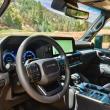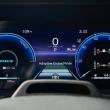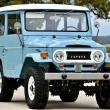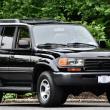Toyota’s ground-pounder reborn: Land Cruiser 4WD Wagon Hybrid
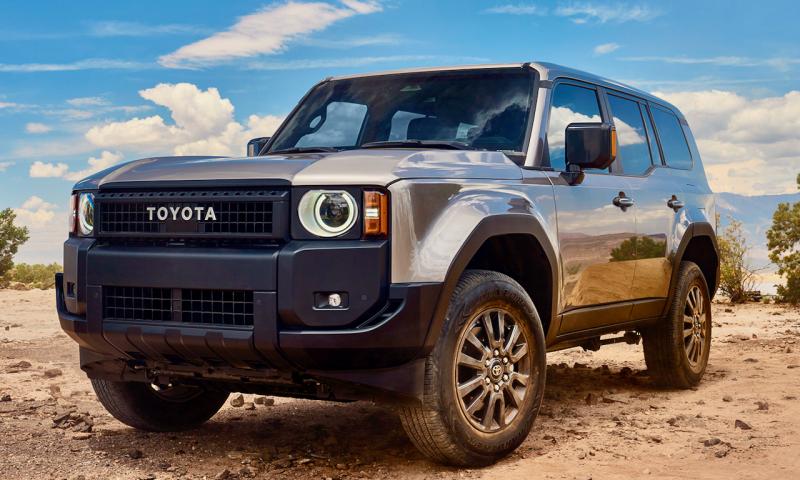 Completely new, this umpteenth version of the Land Cruiser, the 250 Series, appeared in the US last year as a relatively compact (though not small) two-row ute with a hybrid gas-electric drivetrain and serious off-road hard- and software. This color is called Meteor Shower.
Completely new, this umpteenth version of the Land Cruiser, the 250 Series, appeared in the US last year as a relatively compact (though not small) two-row ute with a hybrid gas-electric drivetrain and serious off-road hard- and software. This color is called Meteor Shower.
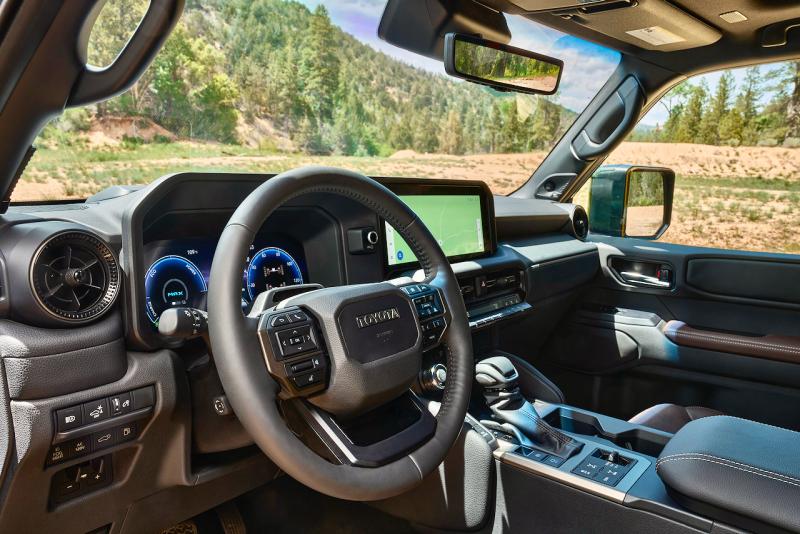 Today’s 250-Series Land Cruiser packs functionality, comfort and convenience into the sort of broad-shouldered and squared-off cabin that suits a brawny off-roader with decent street performance. The switches around the shift lever control the two-speed transfer case, the center and rear locking differentials and the e-brake.
Today’s 250-Series Land Cruiser packs functionality, comfort and convenience into the sort of broad-shouldered and squared-off cabin that suits a brawny off-roader with decent street performance. The switches around the shift lever control the two-speed transfer case, the center and rear locking differentials and the e-brake.
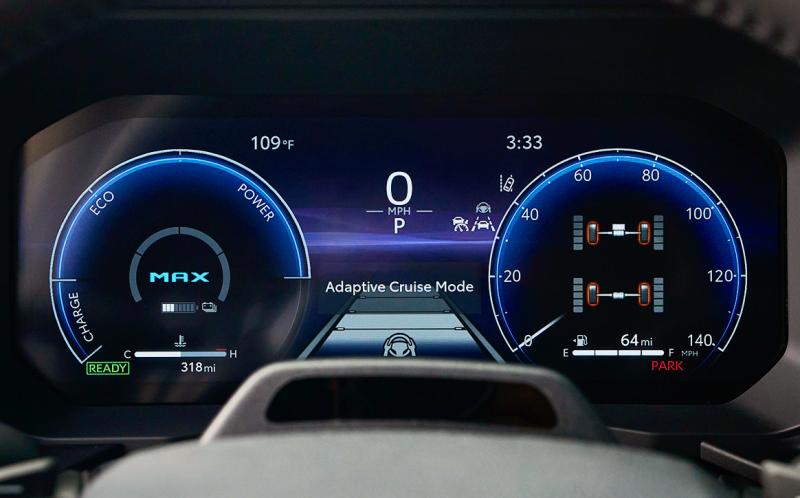 The driver’s screen is, of course, fully digital—these aren’t real dials and needles—and highly informative (as well as customizable), but pleasantly old-school in how it delivers the information.
The driver’s screen is, of course, fully digital—these aren’t real dials and needles—and highly informative (as well as customizable), but pleasantly old-school in how it delivers the information.
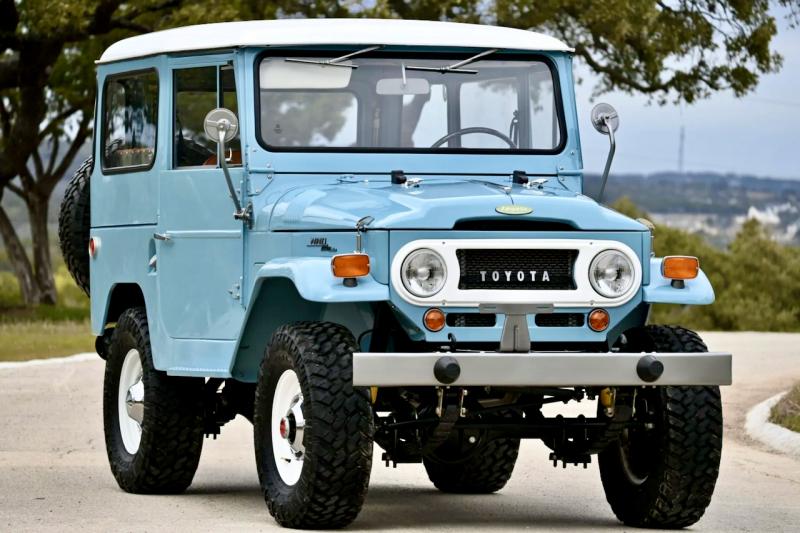 The utilitarian FJ40 Land Cruiser—this is a 1976 model—was available in different configurations and has become an icon and a collector’s item. Like the Jeep CJ and Wrangler, it was descended from a WWII military vehicle.
The utilitarian FJ40 Land Cruiser—this is a 1976 model—was available in different configurations and has become an icon and a collector’s item. Like the Jeep CJ and Wrangler, it was descended from a WWII military vehicle.
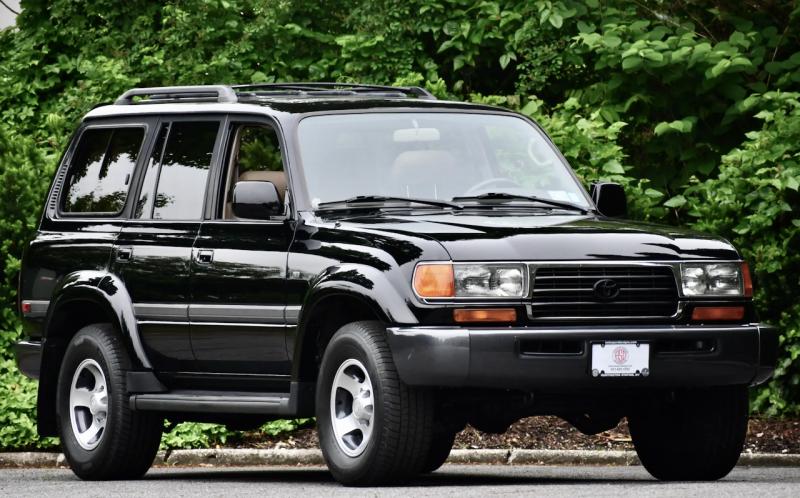 The Land Cruiser FZJ80—this is a 1997 model—competed with the Range Rover as a powerful, luxurious and highly capable on- and off-roader.
The Land Cruiser FZJ80—this is a 1997 model—competed with the Range Rover as a powerful, luxurious and highly capable on- and off-roader.
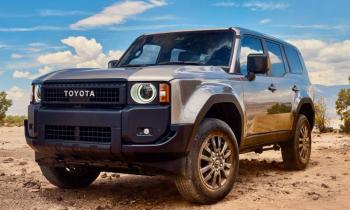 Completely new, this umpteenth version of the Land Cruiser, the 250 Series, appeared in the US last year as a relatively compact (though not small) two-row ute with a hybrid gas-electric drivetrain and serious off-road hard- and software. This color is called Meteor Shower.
Completely new, this umpteenth version of the Land Cruiser, the 250 Series, appeared in the US last year as a relatively compact (though not small) two-row ute with a hybrid gas-electric drivetrain and serious off-road hard- and software. This color is called Meteor Shower.
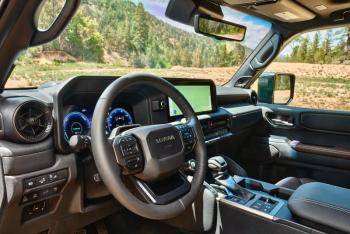 Today’s 250-Series Land Cruiser packs functionality, comfort and convenience into the sort of broad-shouldered and squared-off cabin that suits a brawny off-roader with decent street performance. The switches around the shift lever control the two-speed transfer case, the center and rear locking differentials and the e-brake.
Today’s 250-Series Land Cruiser packs functionality, comfort and convenience into the sort of broad-shouldered and squared-off cabin that suits a brawny off-roader with decent street performance. The switches around the shift lever control the two-speed transfer case, the center and rear locking differentials and the e-brake.
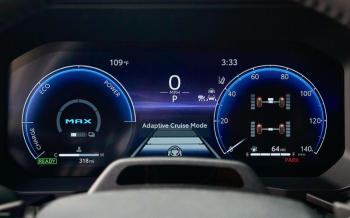 The driver’s screen is, of course, fully digital—these aren’t real dials and needles—and highly informative (as well as customizable), but pleasantly old-school in how it delivers the information.
The driver’s screen is, of course, fully digital—these aren’t real dials and needles—and highly informative (as well as customizable), but pleasantly old-school in how it delivers the information.
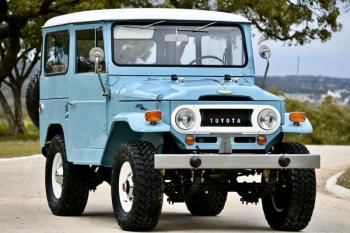 The utilitarian FJ40 Land Cruiser—this is a 1976 model—was available in different configurations and has become an icon and a collector’s item. Like the Jeep CJ and Wrangler, it was descended from a WWII military vehicle.
The utilitarian FJ40 Land Cruiser—this is a 1976 model—was available in different configurations and has become an icon and a collector’s item. Like the Jeep CJ and Wrangler, it was descended from a WWII military vehicle.
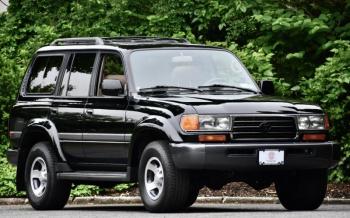 The Land Cruiser FZJ80—this is a 1997 model—competed with the Range Rover as a powerful, luxurious and highly capable on- and off-roader.
The Land Cruiser FZJ80—this is a 1997 model—competed with the Range Rover as a powerful, luxurious and highly capable on- and off-roader.
Toyota began selling something called a Land Cruiser about 70 years ago and since then maybe no automotive badge has been applied to as many different vehicles. The first one I knew was the squared-off, flap-fendered, now-iconic FJ40. In August 1979, four of us drove two heavily loaded examples 530 miles from Calgary, Alberta, to Mile Zero on the Alcan Highway—Dawson Creek, British Columbia—and on to Watson Lake in the Yukon Territory, an epic journey of 600 more miles of then unpaved dirt road. Gnarly, dude.
A month later, we did the trip in reverse. Not in Reverse gear, but from the Yukon back to Calgary and hot showers and martinis. Before and since then, there have been.... I don’t know how many other Land Cruisers. Confusingly, some of them were luxury utes and others were FJ-style blunt instruments. There were long ones and short ones, heavy-duty and light-duty versions, pickup trucks and wagons, hard and soft tops, 8-, 6- and 4-cylinder diesel and gas engines with manual gearboxes and automatic transmissions; some were military vehicles, some had Lexus badges.
There are different Land Cruisers for different markets, too. In South Africa, for example, Toyota still makes something like the old FJ, but somewhat modernized. Every safari operator relies on those Cruisers, invariably painted green or desert tan and retrofitted with winches, racks and outside seats. I know of one with half a million kilometres on the clock. It’s been overhauled so many times that it’s like Grandaddy’s axe—the head’s been replaced twice and the handle three times, but it’s still Grandaddy’s axe!
So here we are in 2025 with yet another Land Cruiser to consider, the new 250 Series. Is it a Tonka Toy, a butched-up, Web-enabled soft-roader with a fancy stereo, automatic multi-zone climate control, driver-safety aids and seat and steering-wheel heat? Or a genuine alternative to the Wrangler, Bronco and Defender—that is, an off-roader with some street capability? Let’s consider the hardware.
First, like all previous Land Cruisers (and most pickup trucks), this one has a steel body mounted to a separate, heavy-duty frame that also supports all the driving bits. So, unlike today’s frameless, unit-body SUVs, the new Land Cruiser can handle a snowplow, a winch or a good-size trailer without risking damage. Towing capacity is 6,000 pounds, which is more than many midsize SUVs are rated for but much less than some full-size pickups can manage.
Appropriately for a modern vehicle, especially one from Toyota, with its 25 years of Prius experience, the new Land Cruiser is a gas-electric hybrid. Under the tall, boxy hood is a turbocharged 2.4-litre gas Four, and in the 8-speed automatic transmission there’s an electric motor; together, they produce a reported 326 horsepower and an impressive 565 pound-feet of torque.
Despite this power and electrification, the new Cruiser’s acceleration is leisurely and its fuel efficiency averages only about 23MPG. This speaks to overall weight—more than 5,000 pounds—as well as full-time 4WD, and possibly the gear ratios too, but the 250-Series Land Cruiser is more fuel-efficient and quicker than its predecessor. Everything is relative.
The new Cruiser is relatively tall, with nearly nine inches of ground clearance, but ingress and egress are easy. It’s sure-footed on the highway, with steering and suspension that, on paper anyway, some sports cars might envy. (It handles and performs far better than the last Toyota 4Runner we drove.) The front seats are comfortable and roomy—the driver’s adjusts electrically—and the back seats are more than tolerable. The ride is truck-like but not jarring. There’s a pleasant engine grumble and some wind noise. This isn’t a vehicle we’d choose to drive from Boston to San Francisco, but it can easily serve as a daily driver, with allowance made for its off-road chops.
These include center and rear locking differentials, for positive power delivery to wheels that need it; a front stabilizer bar that can be disconnected to let the front axle move up and down more freely over rocks and such; and a transfer case that lets the driver shuttle between high- (normal) or low-speed (off-road) gear ranges. These are all push-button, electronically activated systems. There’s also CRAWL, an off-road cruise control with five speeds, and DAC, Downhill Assist Control, which safely walks the Cruiser down a steep grade with no input from the terrified driver other than steering.
Available off-road options include MTS, Multi-Terrain Select, to help manage wheelspin in mud, dirt or sand; and MTM, Multi-Terrain Monitor, which provides the driver with a view of obstacles around the vehicle. There’s also a heavy-duty roof-rack system for luggage, awnings and tents.
Even without venturing into the boondocks with it, the hardware makes it clear that this is no Tonka Toy. Nor would Toyota risk the Land Cruiser’s considerable reputation, which to date has sold more than 10 million of these beasts in all their various configurations. If you’d like to partake, the 250 Series is available in just two trim levels:1958, with a starting MSRP of $57,345, including destination fees, and Land Cruiser, which tops out around $63,500 with all available options. Last year some Toyota dealers were marking up the early First Edition models to about $90,000, but that silliness has abated.
Next week: Acura ADX A-Spec Advance

